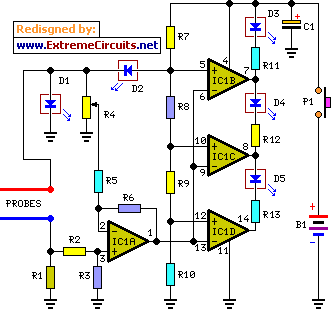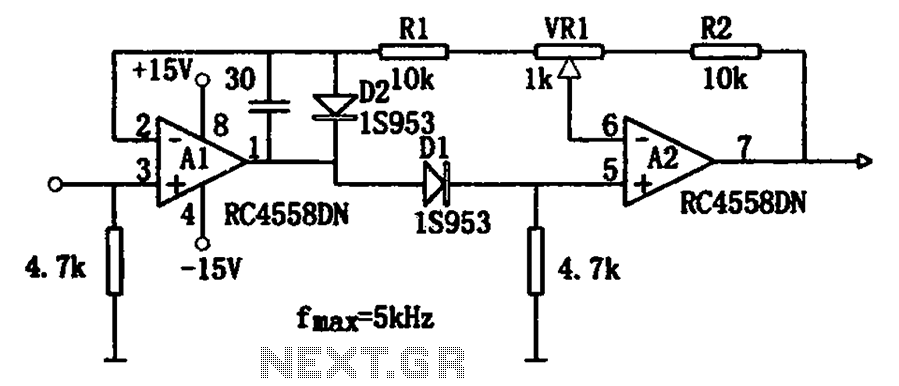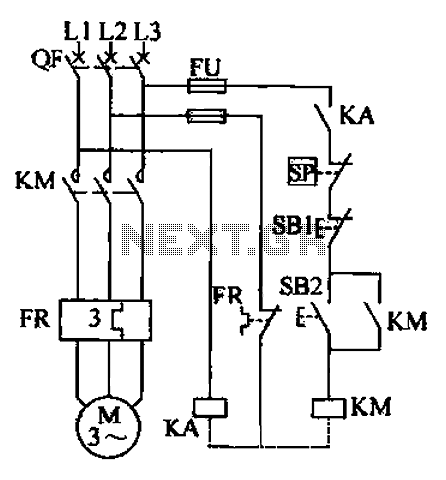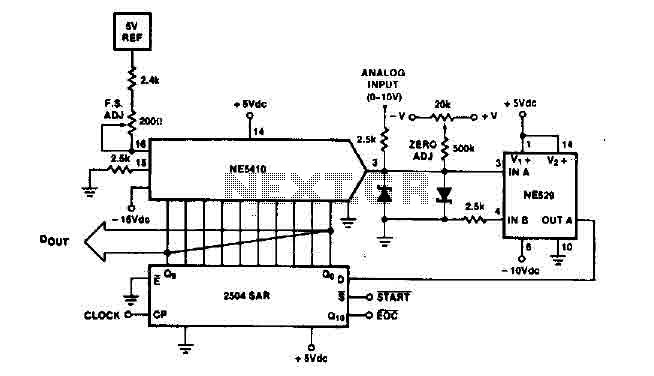
One-chip radar detection circuit

A simple X-band radar detector can indicate changes in RF radiation strength at levels as low as 2 mW/cm². When radiation strikes the detector diode, it generates a voltage at the input of an amplifier. The gain of this amplifier can be adjusted to modify the range at which a warning is issued. The output of the amplifier feeds into a voltage comparator with a variable threshold, which is set to a level that minimizes false alarms. The output of the comparator is connected in a wired-OR configuration with the open collector output of an oscillator operating at a frequency of 2 Hz. In the absence of a signal, the comparator output remains low, inhibiting the oscillator output stage and keeping the buffer in a state that turns the lamp off. When a signal is detected, the comparator output goes high, allowing the oscillator to operate freely, resulting in the lamp being switched on and off at a frequency of 2 Hz.
The X-band radar detector circuit operates by detecting RF radiation and converting it into a usable signal. The detector diode is the initial sensing element, which responds to incoming RF radiation. When RF energy is present, it generates a small voltage proportional to the radiation strength. This voltage is fed into a variable gain amplifier, allowing for sensitivity adjustments to ensure that the detector can operate effectively across various environmental conditions.
The output from the amplifier is then routed to a voltage comparator. This comparator compares the amplified signal against a preset threshold value that can be adjusted to prevent false triggering. The threshold is critical, as it determines the minimum level of RF radiation required to activate the warning system. The comparator's output is binary, providing a high signal when the input exceeds the threshold and a low signal otherwise.
In addition to the comparator, the circuit includes an oscillator configured to produce a square wave signal at a frequency of 2 Hz. This oscillator is connected in a wired-OR configuration with the comparator output. The wired-OR configuration allows for multiple signals to influence the output state. When no RF signal is detected, the comparator output remains low, which keeps the oscillator disabled and the lamp off.
Upon detection of RF radiation, the comparator output transitions to a high state, which releases the inhibition on the oscillator. As a result, the oscillator begins to operate, generating a square wave output that drives the lamp. The lamp thus flashes on and off at a rate of 2 Hz, providing a visual indication of the detected RF radiation. This flashing mechanism not only alerts the user to the presence of RF radiation but also serves as a clear warning signal that can be easily noticed.
Overall, this simple X-band radar detector circuit effectively combines RF detection, signal amplification, and visual indication in a compact design, making it suitable for various applications where RF radiation monitoring is essential.A simple X-band radar detector is capable of indicating changes in rf radiation strength at levels down to 2 mW/cm2. Radiation falling on the detector diode, produces a voltage at the input of an amplifier whose gain may be adjusted to vary the range at which the warning is given.
The amplifier output drives a voltage comparator with a variable threshold set to a level that avoids false alarms. The comparator output is connected in the wired-OR configuration with the open collector output of an oscillator running at a frequency of 2 Hz.
In the absence of a signal, the comparator output level is low, inhibiting the oscillator output stage and holding the buffer so the lamp is off. When a signal appears, the comparator output goes high, removing the lock from the oscillator which free-runs, switching the lamp on and off at 2 Hz.
The X-band radar detector circuit operates by detecting RF radiation and converting it into a usable signal. The detector diode is the initial sensing element, which responds to incoming RF radiation. When RF energy is present, it generates a small voltage proportional to the radiation strength. This voltage is fed into a variable gain amplifier, allowing for sensitivity adjustments to ensure that the detector can operate effectively across various environmental conditions.
The output from the amplifier is then routed to a voltage comparator. This comparator compares the amplified signal against a preset threshold value that can be adjusted to prevent false triggering. The threshold is critical, as it determines the minimum level of RF radiation required to activate the warning system. The comparator's output is binary, providing a high signal when the input exceeds the threshold and a low signal otherwise.
In addition to the comparator, the circuit includes an oscillator configured to produce a square wave signal at a frequency of 2 Hz. This oscillator is connected in a wired-OR configuration with the comparator output. The wired-OR configuration allows for multiple signals to influence the output state. When no RF signal is detected, the comparator output remains low, which keeps the oscillator disabled and the lamp off.
Upon detection of RF radiation, the comparator output transitions to a high state, which releases the inhibition on the oscillator. As a result, the oscillator begins to operate, generating a square wave output that drives the lamp. The lamp thus flashes on and off at a rate of 2 Hz, providing a visual indication of the detected RF radiation. This flashing mechanism not only alerts the user to the presence of RF radiation but also serves as a clear warning signal that can be easily noticed.
Overall, this simple X-band radar detector circuit effectively combines RF detection, signal amplification, and visual indication in a compact design, making it suitable for various applications where RF radiation monitoring is essential.A simple X-band radar detector is capable of indicating changes in rf radiation strength at levels down to 2 mW/cm2. Radiation falling on the detector diode, produces a voltage at the input of an amplifier whose gain may be adjusted to vary the range at which the warning is given.
The amplifier output drives a voltage comparator with a variable threshold set to a level that avoids false alarms. The comparator output is connected in the wired-OR configuration with the open collector output of an oscillator running at a frequency of 2 Hz.
In the absence of a signal, the comparator output level is low, inhibiting the oscillator output stage and holding the buffer so the lamp is off. When a signal appears, the comparator output goes high, removing the lock from the oscillator which free-runs, switching the lamp on and off at 2 Hz.





